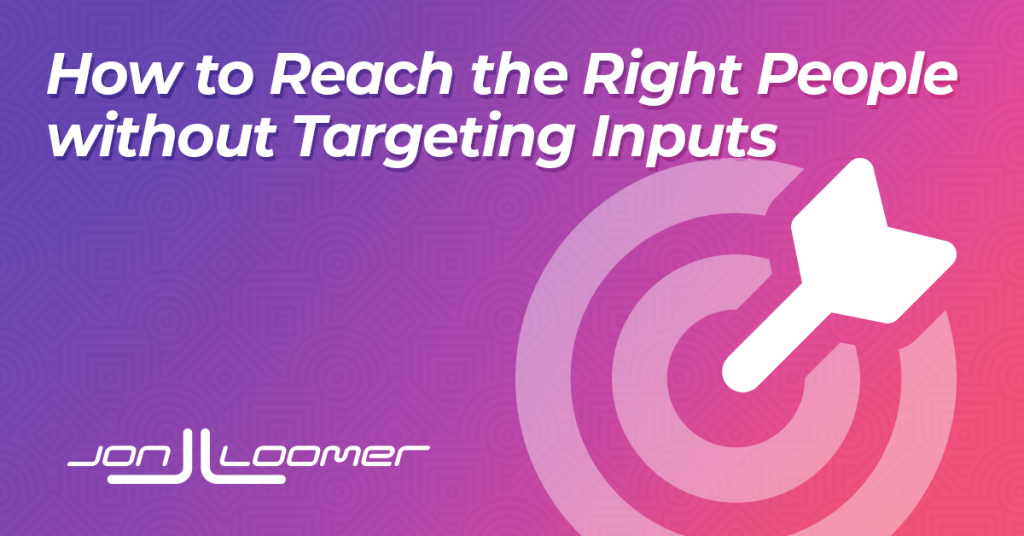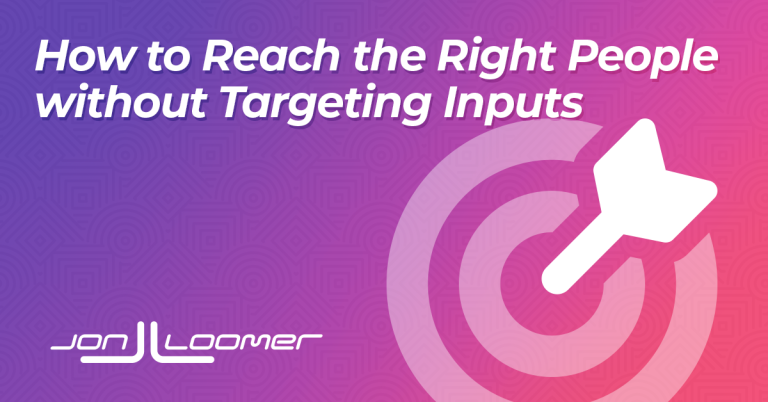
The outdated strategies of focusing on management are both ineffective or irrelevant now. In case your marketing campaign building course of consists of obsessively flipping focusing on switches, you’re losing your time. You could even be hurting your outcomes.
The explanation many advertisers are caught in these outdated methods is that they fall for myths in regards to the steering Meta wants to succeed in their excellent viewers. In some instances, these myths have been beneficial finest practices at one time. In all, they make affordable sense and are based mostly on notion, quite than actuality.
My aim is to make the case to push you away from these outdated strategies. I don’t need to bully you away from the stuff you’ve all the time finished. As a substitute, my hope is {that a} lightbulb second happens the place you perceive why your function is completely different now.
Most significantly, I would like you to divert your power to far more productive actions. Whereas older strategies could also be far much less obligatory now, you continue to retain a task that helps information Meta to your excellent buyer.
Let’s get to it…
Previous Strategies are Ineffective or Irrelevant
In an effort to make this obligatory shift, it’s essential that you simply perceive that most of the focusing on methods you’re utilizing are not efficient or related. They both try to manage one thing that may’t be managed or present focusing on steering that Meta doesn’t want.
Detailed Concentrating on
You’ve doubtless observed that your detailed focusing on (also called pursuits and behaviors) choices maintain shrinking. Meta has eliminated hundreds of detailed focusing on choices to forestall misuse. They’ve additionally consolidated narrowly-focused choices whereas leaving the broadest to outlive.
And even while you present detailed focusing on choices, you’re hardly ever limiting the viewers. If you happen to’re optimizing for conversions, worth, hyperlink clicks, or touchdown web page views, your detailed focusing on inputs are solely used as viewers recommendations.
Based mostly on my checks, it’s questionable whether or not viewers recommendations are given a lot weight in any respect. They gained’t damage you, however recommendations are little greater than a solution to make you are feeling such as you’re contributing to outcomes.
Lookalike Audiences
Just like detailed focusing on inputs, your lookalike viewers inputs are solely used as recommendations when optimizing for conversions or worth.
Lookalike audiences are sometimes 1-2 million folks (generally greater) with out Meta increasing it. So if it’s used as a suggestion, it’s questionable whether or not it’s altering supply in any respect.
Since you ought to be optimizing for some kind of conversion generally, your lookalike viewers isn’t offering the path you assume it’s. It’s unlikely that it’s hurting outcomes, but it surely certainly isn’t required for good efficiency both.
Age and Gender
When utilizing the brand new Benefit+ marketing campaign setup or Benefit+ Viewers with the outdated setup, any age and gender inputs you present are viewers recommendations.
When you can prohibit your viewers by age and gender, it’s not typically advisable. Particularly in case you are optimizing for a purchase order, your restrictions typically do extra hurt than good.
Location
I’m not suggesting that location is pointless now and that you must simply go away it clean or use the “Worldwide” area. It is best to isolate your focusing on to the related international locations that you simply serve. If you happen to’re an area enterprise, you must try to limit your focusing on to your native space.
However the important thing phrase right here is try. Location focusing on is extraordinarily restricted now. There was a time when you can isolate the individuals who lived in a sure location or have been touring. However now the one possibility is “residing in or not too long ago in” the situation.
I get the frustration of those that solely need to attain locals or vacationers. Whereas there are some issues you must do (see later on this put up), the answer isn’t discovered inside focusing on.
Remarketing
This one is the hardest promote for advertisers who make remarketing a significant a part of their technique. They see the outcomes, so it’s almost unimaginable to persuade them that their efforts are doubtless pointless.
I do know this as a result of I used to be certainly one of these advertisers. A really excessive share of my finances was spent on remarketing for a few years, and my eyes informed me that it was the best strategy. However I used to be incorrect.
There are some essential truths about remarketing that it’s essential to perceive:
1. Remarketing occurs naturally now. If you happen to’re like me, you gained’t settle for this blindly. Ensure that to outline your viewers segments in Promoting Settings. Then break down gross sales marketing campaign outcomes by viewers segments. You could uncover that wherever from 20-40% of your finances is being spent on remarketing audiences.
Based mostly on my checks, there’s no indication that utilizing customized audiences as recommendations impacts distribution in any respect. Meta will naturally prioritize these folks as a result of they’re amongst these more than likely to carry out the motion that you really want.
2. Remarketing isn’t scalable. Most remarketing audiences are small, so limiting your focusing on to individuals who solely go to your web site or carried out a sure motion will lead to a quickly-exhausted viewers. The quantity you’ll be able to spend is restricted, which additionally limits your potential outcomes. However you can scale in the event you focused broadly, which incorporates your remarketing audiences anyway.
If you happen to’re coping with a really restricted finances, I get the attractiveness of relying fully on remarketing if it will get outcomes. However even then, I’d contemplate a broader strategy first.
3. Outcomes are inflated and lack incrementality. The inflated outcomes discovered with remarketing are why advertisers are so proof against abandon it. A excessive share of your conversions are doubtless view-through. Your advert was proven to somebody who additionally acquired an e-mail or noticed one other put up from you later that day and acted on it. Even when the outcomes are click-through, your advert was doubtless certainly one of many efforts that contributed to the conversion.
In different phrases, remarketing isn’t incremental. It’s not that your advert didn’t make any influence in any respect, however a portion of your conversions would have occurred with out your advert. This share is far greater for remarketing than it could be for a chilly viewers.
Learn Extra About Concentrating on Now
I wrote one other put up that breaks down the evolution of those focusing on choices. Learn it right here:
Concentrating on Myths
I’ve discovered there’s a constant theme of beliefs that many advertisers have which are hooked to the outdated methods of focusing on. These myths have to be busted…
“Meta wants pursuits and behaviors to isolate folks considering my product.”
This simply isn’t true. Perhaps it was at one time. However Meta is working with mounds of historic information and numerous real-time alerts to find out who ought to see your advertisements. Meta doesn’t want you to offer an viewers suggestion of individuals considering baseball to know that your baseball-centric product ought to be proven to folks considering that subject.
When you’ve got any doubts about this, click on on an advert for sneakers or another product. You’ll then be served numerous advertisements from completely different advertisers and types selling related merchandise. It’s not as a result of these advertisers listed “sneakers” as an curiosity. It’s as a result of Meta is aware of learn how to leverage alerts from person exercise.
“Meta wants a lookalike based mostly on my prospects to seek out folks like them.”
I hope that that is the simplest fable to bust. Lookalike audiences have been launched in 2013. That’s proper, 12 years in the past. They have been an enormous improvement then as a result of they allowed advertisers to higher information Meta to folks much like our prospects, quite than going via the infinite loop of attempting to outline them with pursuits and behaviors.
However issues are completely different now. Assuming we’re sending Meta conversion occasions, the record of our prospects isn’t a thriller. Meta is aware of who’s participating with our content material, visiting our web site, on our e-mail record, and shopping for from us.
Do you really consider that Meta is unable to attach the dots to seek out prospects based mostly on these alerts with out particularly offering a lookalike viewers as a suggestion? Meta doesn’t want your lookalike viewers anymore. Algorithmic focusing on behaves as one massive lookalike viewers now.
“Meta wants age and gender restrictions that mirror my excellent buyer.”
As soon as once more, Meta in all probability is aware of extra about your excellent buyer and potential buyer than you do. If you happen to promote males’s clothes for an viewers typically between 25 and 44, it’s extremely unlikely that it’s essential to prohibit focusing on to males in that age group when optimizing for a purchase order. The algorithm is aware of who is probably going to purchase.
We’ve seen this within the wild. A enterprise that caters to girls relied on algorithmic focusing on and no gender restrictions. The algorithm knew to prioritize girls and spent 99% on that demographic.
What hurt can it do, although, proper? Properly, you might be limiting your self unnecessarily. If you happen to promote males’s clothes, a feminine companion could also be who makes the acquisition. If you happen to restrict to 25-44, your 45-year-old potential buyer can’t be reached.
When this works correctly, our anticipated “excellent buyer” age and gender will nonetheless be prioritized, however you’re given the opportunity of reaching others if it might result in the motion that you really want.
“Meta wants my remarketing audiences as a result of they work the very best.”
No, Meta definitely doesn’t. This primary grew to become evident when Benefit+ Viewers was rolled out. Meta stated then that in the event you didn’t present viewers recommendations, they’d prioritize pixel exercise, conversion information, and prior engagement along with your advertisements. In different phrases: Remarketing.
Typically, you don’t want to limit focusing on to your web site guests or e-mail record or individuals who have interaction along with your content material on Fb and Instagram. Meta already is aware of how invaluable these persons are, and so they’ll be prioritized.
The right way to Impression Who Sees Your Adverts
Now, right here’s the issue: If you happen to take a totally hands-off strategy from focusing on inputs, you aren’t assured to succeed in a related viewers along with your advertisements. There may be further work it’s essential to do to make certain that occurs.
1. Efficiency Purpose
I can’t emphasize sufficient how vital that is. The algorithm is literal, so Meta will work laborious to get outcomes that match your aim motion. That aim motion is outlined by your efficiency aim.
If you happen to optimize for the motion you need most (usually a conversion of some kind), Meta will do the very best job of digging via information and alerts to seek out the individuals who match your excellent buyer.
However in the event you optimize for some top-of-the-funnel motion and assume that Meta will nonetheless care about reaching individuals who will finally purchase from you, you’re sadly mistaken. Your advertisements will probably be delivered to people who find themselves prone to click on or watch or have interaction. However that will have completely nothing to do with making an eventual buy.
In some ways, the efficiency aim directs focusing on now. Deal with it with the extent of significance that it deserves.
2. Exercise and Historical past
The explanation that offering lookalike and remarketing audiences is usually pointless now’s that Meta ought to have the info to prioritize your present prospects and folks like them by default. In the event that they don’t, that can clearly be an issue.
One among your tasks is to make certain that Meta is receiving conversion occasion information, whether or not it’s internet or CRM occasions, in order that exercise carried out by your most vital folks is already identified. This may be a prerequisite to conversion optimization within the first place, in fact.
That is the place I’ll typically get questions like, “Properly, what about new companies that don’t have this historical past?” The unlucky reality is that you simply’re at a drawback.
Meta isn’t working blindly, in fact. The algorithm will nonetheless be taught from the exercise that is available in. However in the event you lack that basis of historic information, you’re lacking a fairly important supply of algorithmic studying.
Does that imply that you must prohibit focusing on audiences to counter these limitations? In all probability not. You gained’t be capable to prohibit by detailed focusing on or lookalike viewers anyway when optimizing for conversions. You may present them (and customized audiences) as recommendations if you’d like, however I wouldn’t resort to that strategy instantly.
3. Copy and Inventive
You’ve doubtless heard some model of “Concentrating on occurs in your advert now,” and there’s a complete lot of reality to it. How precisely this occurs isn’t utterly clear, however there are particular issues that we all know.
Some have theorized that Meta scans the copy and artistic to assist decide who ought to see our advertisements. Whereas that’s potential, it wouldn’t be obligatory for this stuff to influence who sees your advertisements.
Have a look at copy much less from a perspective of needing key phrases that Meta scans, since we don’t know that it occurs. Look as an alternative at how copy and artistic can both appeal to or repel an viewers.
Use copy to talk on to your excellent buyer. Concentrate on their distinctive life-style, experiences, and ache factors. Your product isn’t for the overall inhabitants as a complete, and it’s vital that your copy displays that.
Is your product for promoting executives who personal an company and handle tens of millions of {dollars} in promoting? Then you must say that. Be clear who your product is for and whom it advantages. Don’t cover from worth in case your excellent buyer values luxurious.
You may also use copy to repel the dangerous suits. Be keen to make use of copy to push folks away. Take a transparent stand on what kind of particular person isn’t your excellent buyer.
And likewise use artistic and imagery to do the identical. Use it to mirror the lifetime of your audience. If you happen to serve retirees, you’d clearly need to characteristic folks within the 60+ vary. Use imagery that displays their life and experiences.
Attracting and repelling with copy and artistic are an enormous a part of the way you influence who sees your advertisements.
4. Your Supply
This ought to be apparent. It’s not ok for your supply to be compelling. A free iPad is a compelling supply to subscribe to an inventory. Your supply must be uniquely compelling to your goal demographic.
In some instances, it might solely be attention-grabbing to your excellent buyer. However they get it, and so they need it.
Whereas reductions are typically strategy to extend gross sales, they aren’t proper for everybody. In case you are promoting a luxurious merchandise to an viewers with important expendable revenue, a reduction may very well mirror poorly in your product. The upper worth might mirror worth to the best folks.
5. Impression Who Completes the Motion
Let’s put this into easy phrases that almost all advertisers perceive. Take into consideration the educational part. Through the first week, Meta’s supply algorithm is studying out of your outcomes to make changes to who sees your advertisements. The outcomes mirror when folks carry out the motion you need, as outlined by the efficiency aim.
This can be a essential time period, significantly for lead assortment. Meta doesn’t know or care in regards to the high quality of the leads who full your kind. The one care is that somebody carried out the motion that you really want. The algorithm will be taught from it.
So the aim ought to be to make it possible for your excellent lead completes the shape whereas the dangerous match doesn’t. This may be achieved via the questions you ask and the way you deal with their solutions.
For instance, in case your excellent buyer is an company proprietor, your kind ought to ask questions like these:
- Do you personal an company?
- What number of shoppers does your company have?
- How a lot cumulative advert finances do you handle?
- What industries are your advert shoppers in?
It’s potential that the questions themselves can be sufficient to push away the non-agency proprietor. If not, you can apply some logic that handles the leads in another way based mostly on how these questions are answered.
If you happen to use prompt kinds, you’ll be able to apply conditional logic to kick folks out of kinds who don’t reply the best way you’d like. If you happen to use a web site kind, you can use some artistic programming to ship folks to completely different affirmation pages (one which triggers an occasion and one which doesn’t) based mostly on how questions are answered.
It’s vital to recollect how vital these accomplished actions are to Meta’s studying course of. You may influence it in constructive methods, which additionally has an impact on who will finally see your advertisements.
A Abstract: Your Method
Let’s summarize how you must strategy the varied methods you could influence who sees your advertisements…
1. Let go of focusing on inputs.
Typically, these restrictions aren’t serving to. And by letting go of what little management you had there, you’re releasing your self as much as deal with issues that matter far more.
2. Focus the place it issues.
If you happen to’re not reaching a related viewers, the intuition will probably be to move again to focusing on controls. Resist this urge. As a substitute, assume extra about why the incorrect persons are being proven your advertisements.
Are you utilizing the best efficiency aim? Do the copy and artistic attraction to your goal demographic whereas repelling those that aren’t match? Is your supply enticing to the best folks? Can you influence who completes your required motion to assist the algorithm be taught?
Begin there. That is the place you may make essentially the most influence. If you happen to aren’t getting the outcomes you need, it’s virtually all the time due to your advertisements. View focusing on restrictions as a final resort.
Exceptions and mirages
I’ll get loads of disagreement on this strategy. Advertisers will swear by their focusing on restrictions due to the outcomes that they get.
In some instances, these are purely mirages. You’re getting good outcomes out of your detailed focusing on or lookalike audiences, but it surely doesn’t essentially imply that using these inputs is what triggered the outcomes (correlation vs. causation).
In others, sure, there are exceptions when you must contemplate further focusing on restrictions, if they’re potential. However in lots of instances, these restrictions aren’t potential within the first place (you simply assume you’re limiting the viewers). In others, there’s a really particular downside that’s distinctive to what you are attempting to perform that requires some further management.
Have an ordinary strategy and know that deviating from it is going to be an exception to unravel an issue.
Your Flip
Are there every other artistic strategies you utilize to influence who sees your advertisements?
Let me know within the feedback beneath!















